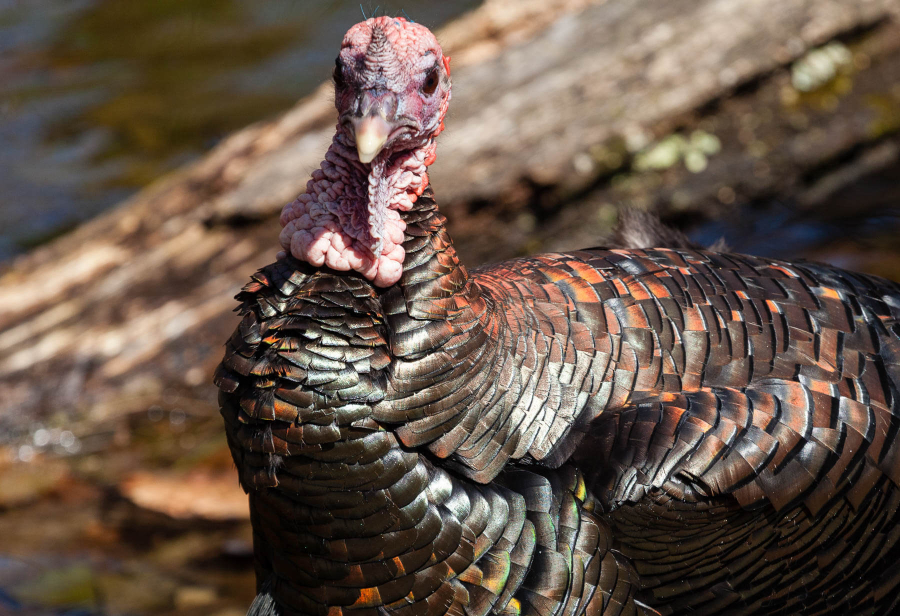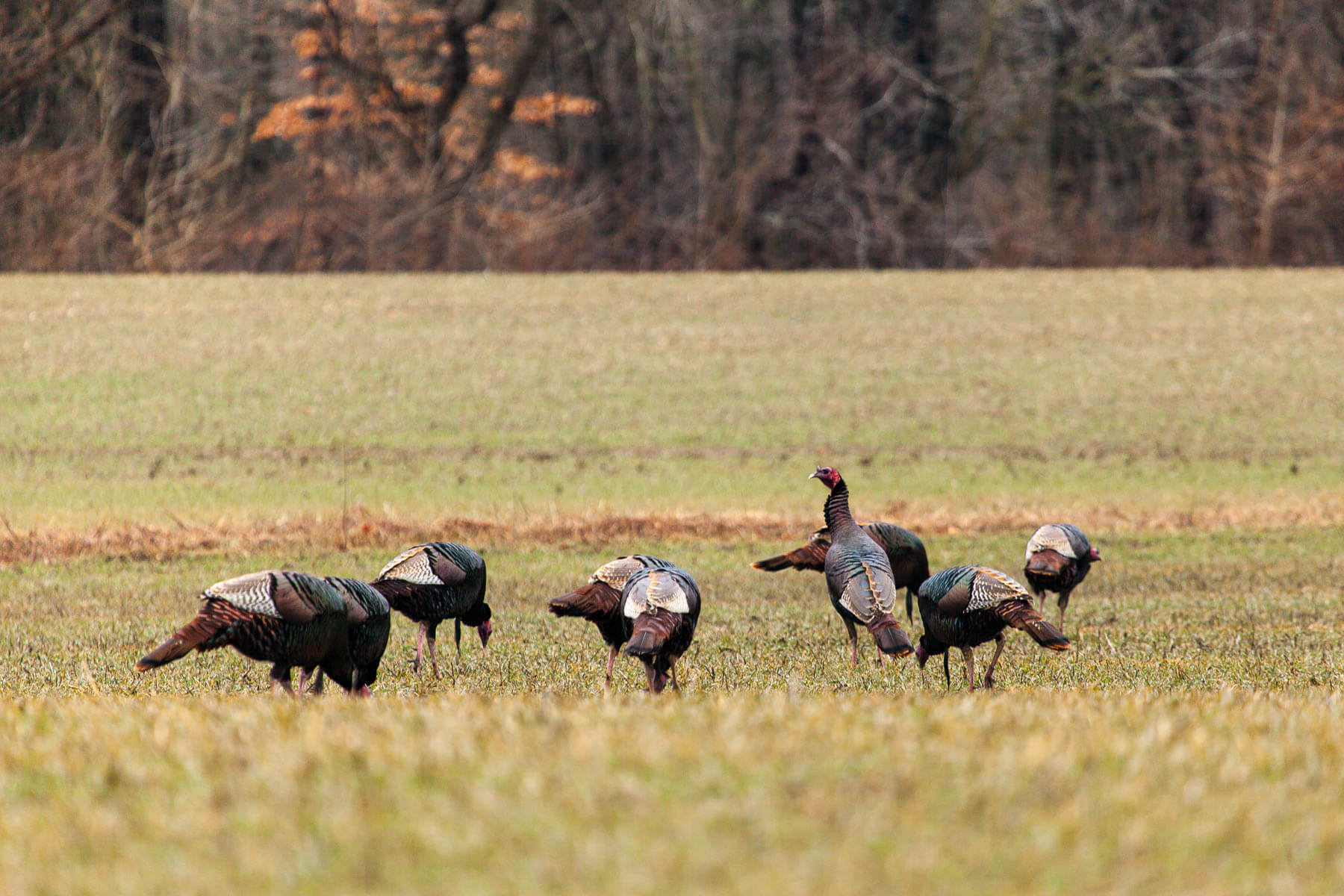The greatest wildlife comeback you've never seen

You could go your whole life without ever seeing one, though they live in almost every county in the Chesapeake region. Visit nearly any forest or farm with a decent acorn spread and insect population and they'll be there. But before you have a chance to spot one, the wild turkey will sense your presence and disappear.
“They’re really good at avoiding danger,” said Bob Long, upland game bird & turkey project manager for the Maryland Department of Natural Resources. “Their hearing is tremendous. Their eyesight is just unbelievable...They’re paranoid about every single thing.”
Every once in a while, a wild turkey will make headlines by visiting the suburbs and wreaking a bit of havoc, but by and large, the bird remains in the wild and out of sight. As of 2021, there were roughly 40,000 wild turkey in Maryland, 180,000 in Virginia, and 159,000 in Pennsylvania—numbers that are good enough to invite hunters to harvest the elusive bird each season.
But if you look back just ten years, you’ll find that the wild turkey has only recently recovered from tragic lows. And the population we have today is something we should all be thankful for.
Wild turkeys make restoration history
Wild turkeys were once so abundant in the Mid-Atlantic region that they became the centerpiece for big feasts and a symbol for thankfulness. But like many other critters, their numbers started to decline after the arrival of European colonists, who began hunting and deforesting the land.
By the 1930s, there were just 3,000 wild turkeys in all of Pennsylvania and a few hundred in states like Maryland and Virginia, prompting wildlife managers to band together for large-scale conservation.
The effort got off to a rocky start. For a while, states were attempting to raise poults (wild turkey offspring) in captivity and then release them into the wild, resulting in turkeys that were woefully unequipped to avoid predators. But by the mid-1960s and early 1970s, conservationists changed their strategy. With the help of the recently invented cannon net, state wildlife managers and the National Wild Turkey Federation worked together to capture wild turkeys in the regions where they still existed and reintroduce them to other areas with suitable habitat.
In the Chesapeake watershed, turkeys in mountainous western Maryland became Eastern Shore residents, those in Pennsylvania’s Appalachian region hitched a ride east and Virginia’s Piedmont turkeys found a home closer to the nation's capital. Once relocated, the birds were able to thrive in the wild, especially as hunting became more strongly regulated and wildlife managers refined their ability to manage turkey habitats.
By the early 2000s, when the last trap and transfer efforts in the Chesapeake watershed took place, wild turkey populations were as high as they’d been in nearly 100 years.

Keeping an eye on the Thanksgiving bird
Though turkey populations rebounded, wildlife managers are still very much involved in the bird’s survival—careful not to count their eggs before they hatch.
Since the early 2000s, “our populations have been fluctuating up and down,” said Mary Jo Casalena, a wild turkey biologist at the Pennsylvania Game Commission. “And they’ve been on the decline for a while now.”
Like Long, Casalena spends a bulk of her time making sure that wild turkeys have suitable habitat. The species is famously adaptable, but it greatly benefits from forests with adequate nut or fruit production and a diverse age of trees (old, tall trees to roost in and young, short shrubs to hide under). With these conditions in mind, wildlife managers will plant and manage for trees that produce mast (edible nuts or fruit) like oak, hickory and beech. They will also conduct controlled burns to give those trees, as well as younger plants, room to grow.
When done correctly, land management not only benefits wild turkeys, but also the forest ecosystem overall. For example, forest buffers that reduce stormwater runoff can also provide shelter and food for wildlife, if the trees selected produce nuts or fruit.
“We try to plant a wide diversity of species on our projects that are going to provide a diversity of food sources for a diversity of wildlife throughout the year,” said Craig Highfield, the director of forest programs at the Alliance for the Chesapeake Bay, whose primary goal is to improve the water quality of local streams.
Another member of Highfield’s team, Ryan Davis, said that in choosing which species to plant, he emphasizes “thicket-forming shrubs which will provide shelter” from weather and predators. “Establishing herbaceous habitat for turkeys to raise their poults in is also super important, and something that we often do as part of reforestation work,” Davis said.
The wild turkey, a true survivalist
Wildlife managers protecting wild turkeys are keenly aware of another factor—climate change.
The uncharacteristically cold and wet springs occurring in the Chesapeake region as a result of climate change, for example, are hurting wild turkeys’ ability to breed and brood their young. The cold temperature keeps hens from nesting until late in the season, and too much rain can result in a phenomenon known as ‘wet hen syndrome,’ in which a hens’ soaked feathers will release an odor that attracts predators. When summers are also cold and wet, hens have to brood their poults longer, depleting their energy and leaving the poults with less time to feed. When poults have less time to feed, their flight feathers take longer to grow, which means they are more susceptible to predators as they’re unable to fly and roost in trees.
“This year we had pretty good weather during the spring, so we had a pretty decent hatch,” Casalena said. But with the weather becoming more variable, she remains cautious. “If you have several years in a row of poor hatches then you basically lose a few recruitment years.”
Hunting is another major variable in wild turkey conservation. Much like the harvest limits set on blue crabs or oysters, wild turkey regulations change year-to-year as biologists survey their numbers. According to Casalena, the Pennsylvania Game Commission has the most conservative hunting restrictions in the region because hunting is so popular in the state. Pennsylvania doesn’t begin its hunting season until about 50% of turkey hens are incubating their nests.
However, when hunting is open, the wild turkey is still a tough bird to harvest. Long, who is a turkey hunter himself, appreciates the critter’s ability to survive despite danger from all sides.
“Foxes, bobcats, coyotes, great-horned owls and a variety of other predators are hoping to make a meal out of turkeys," Long said. "And hunters will also go to great lengths to get a turkey in range."
Luckily, the wild turkey has its natural wits and a handful of wildlife specialists on its side.

Comments
There are no comments.
Thank you!
Your comment has been received. Before it can be published, the comment will be reviewed by our team to ensure it adheres with our rules of engagement.
Back to recent stories